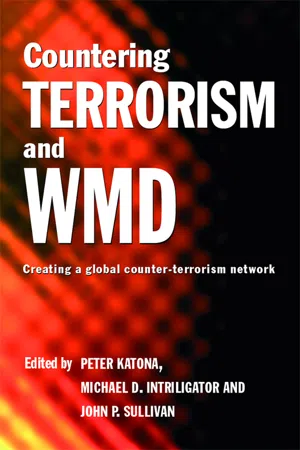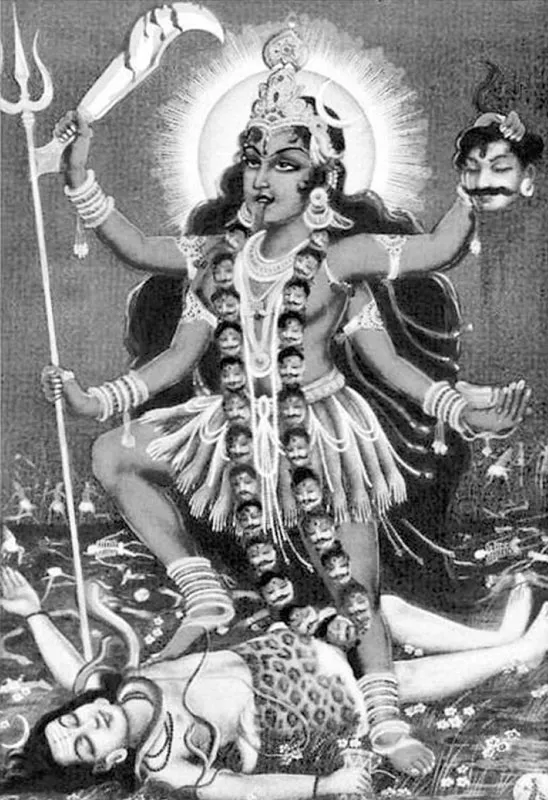1
THE HISTORICAL IMPACT OF TERRORISM, EPIDEMICS AND WEAPONS OF MASS DESTRUCTION
Peter Katona
Introduction
Throughout history, academics, politicians, security experts and journalists have employed a variety of definitions of terrorism. Some focus on terrorist organizations’ modes of operation while others emphasize the motivations and characteristics of terrorism or the modus operandi of individual terrorists. Before we look at the history of terrorism, we need to understand what the term “terrorism” actually means. There is no universally accepted definition of terrorism; even when people do agree on a definition, they may disagree about whether or not the definition fits a particular incident. The National Memorial Institute for the Prevention of Terrorism uses the defi-nition “premeditated, politically motivated violence perpetrated against non-combatant targets by sub-national groups or clandestine agents, usually intended to influence an audience.”1 The United Nations definition also excludes states that sponsor terrorism, while the US definition includes them and names specifically Cuba, Iran, Libya, North Korea, Sudan and Syria, as noted in Table 4.2 (p. 74).
As discussed by Boaz Ganor, Schmidt and Youngman, in their book Political Terrorism, noted more than 100 definitions of terrorism from a survey of leading academics, and isolated certain recurring elements and unresolved issues.2
The recurring elements in the definition of terrorism were:
- violence or force (appeared in 84 percent of the definitions);
- political (65 percent);
- fear or emphasis on terror (51 percent);
- threats (47 percent);
- psychological effects and anticipated reactions (42 percent);
- discrepancy between the targets and victims (38 percent);
- intentional, planned, systematic, organized action (32 percent);
- methods of combat, strategy, tactics (31 percent).
The unresolved issues in the definition of terrorism were:
- The boundary between terrorism and other forms of political violence.
- Whether government terrorism and resistance terrorism are part of the same phenomenon.
- Separating “terrorism” from simple criminal acts, from open war between “consenting” groups, and from acts that clearly arise out of mental illness.
- Is terrorism a sub-category of coercion, violence, power or influence?
- Can terrorism be legitimate? What gains justify its use?
- The relationship between guerrilla warfare and terrorism.
- The relationship between crime and terrorism.
Terrorism has three important elements: First, there is violence. An activity that does not involve violence or a threat of violence will not be defined as terrorism (including non-violent protest—strikes, peaceful demonstrations, tax revolts, etc.). A violent activity against civilians that has no political aim is, at most, an act of criminal delinquency, a felony or simply an act of insanity unrelated to terrorism. Second, the goal is to attain political objectives: changing the regime, changing the people in power, changing social or economic policies, etc. There may also be ideological or religious aims. The concept of “political aim” is sufficiently broad to include these goals as well. The motivation behind the political objective—whether ideological, religious or something else—is irrelevant. Finally, do the targets of terrorism have to be civilians? Terrorism is thus distinguished from other types of political violence such as guerrilla warfare or civil insurrection. Terrorism exploits the relative vulnerability of the civilian “underbelly”—the tremendous fear and anxiety, and the intense media reaction evoked by attacks against civilian society’s seams and soft targets. Fear creates uncertainties that government will not protect its citizens and that quality of life will be adversely affected. With all this in mind, the phrase “global war on terror” is inconsistent and misleading since it implies that terror is an enemy rather than a tactic.
Historically, terrorism has taken many forms. Initially, there were individual acts, or small-scale acts committed during wars. The motivation of religion entered early and has persisted, recently adding a more virulent fanaticism. The terrorist and non-terrorist use and proliferation of all forms of weapons of mass destruction (WMD) emerged in the twentieth century:
- Chemical weapons were used by both sides in WWI, by Iraq against Iran and its indigenous Kurd population, and in Tokyo’s Aum Shinrikyo sarin gas attack.
- Nuclear weapons were used by the US against Japan to end WWII.
- Biological weapons were used by Iraq against the Kurds (aflatoxin),3 by unknown perpetrators against US senators and media executives (the anthrax letters), by the Japanese against the Chinese (anthrax, cholera, plague, salmonella and other agents) and by the Bhagwan in the salad bar contamination in Oregon (salmonella).
Civilization has also been coping with the turbulence and terror of natural epidemics such as smallpox, plague, typhus and influenza for thousands of years. The first influenza epidemic was recorded by Hippocrates in 412 bc,4 although the domestication of chickens may have brought outbreaks as far back as 2,500 bc in the Orient.5 Since then, influenza epidemics have periodically caused widespread morbidity and mortality. The Spanish influenza outbreak of 1918–1919, for example, caused tens of millions of deaths and may have killed more people than any other epidemic in history. Now, a century later, we are facing a similar issue: the possibility of the avian (H5N1) influenza virus mutating to spread from human to human, causing a global pandemic of enormous proportions.
The great plagues of the Middle Ages caused massive destruction and disruption medically, sociologically and economically. Jared Diamond in Guns, Germs and Steel noted that, during modern and ancient wars, infectious diseases killed or wounded more soldiers and civilians than bombs or bullets.6 Smallpox, for example, killed about 300 million people during the twentieth century—three times the number directly killed in all wars during that century.
Biological agents intentionally used as weapons may become the agents of choice in the future. They are cheap and easy to use; the recipes are easy to acquire; and they can cause great fear and panic. Despite this, there are also drawbacks that may have prevented their use: their effects are highly unpredictable; they depend on the cooperation of weather conditions such as temperature, humidity, wind and inversions; they are socially unacceptable to most of us; and the production of true “weaponized” or genetically altered biological agents requires experienced microbiologists with knowledge of advanced “weaponization” technology.7 An efficient dispersion device requires knowledge of physics, weather and aerobiology to be effective. As technology advances, the pros of their use will overcome the cons.
Early history: the Sicarii, Zealots, Assassins and Thugees
The Greek historian Xenophon (c. 431–c. 350 bce) first wrote of the effectiveness of psychological warfare against enemy populations.8 Roman emperors such as Tiberius and Caligula, who reigned 14–41 ce, used banishment, expropriation of property, and execution as a means of terror to discourage opposition.
Ancient acts of bioterrorism and biowarfare were local events and consisted of contaminating water supplies, hurling snakes on to the decks of enemy ships9 or deliberately introducing infectious diseases among enemy forces. Roman armies used the bodies of animals and humans to contaminate water supplies.10 It is unclear just how effective these and similar efforts were. Given the problems of sanitation in those times and the natural prevalence of waterborne and other infections, a further degradation of water quality probably contributed only marginally to general morbidity, and it is doubtful that such efforts significantly altered the course of history.
More organized terrorist history goes back to the times of the Sicarii, Zealots, Assassins and Thugees. The Sicarii and the Zealots were Jewish terrorist groups active during the Roman occupation of the Middle East during the first century. Their favored weapon was the sica, or hort dagger, which gave them their name, literally meaning “dagger men.” They murdered those (mainly Jews) they deemed apostate. The Zealots, who targeted Romans and Greeks, give us the modern term “zealot,” meaning “a fanatical partisan.” Just as terrorists today seek media attention, so the Zealots usually killed in broad daylight in front of witnesses, sending a clear message to the Roman authorities and the Jews who collaborated with them. Their most famous act—committing mass suicide to avoid capture—occurred at Masada near Jerusalem in 70 ce. 11
Adherents of other religions also resorted to methods that today might be termed terrorism. The Assassins, founded by Hasan ibn al-Sabbah as an offshoot of the Isma ili Shia Muslim sect, were active between 1090 and 1272. In 1090, Hasan and a band of followers seized a mountain fortress in current Iran known as Alamut. From there, Hasan, who became known as the “Old Man on the Mountain,” sent out secret agents to kill his enemies. The tactic was to find young, impressionable youths to be hired killers, analogous to some of today’s Muslim suicide terrorists. They were drugged, transported to “paradise” by the intoxication, and upon awakening were promised the afterlife. These young men were then assigned to go to a destination and wait for instructions, much like today’s “sleeper agents.” Like the Zealots and Sicarii, the Assassins were also given to stabbing their victims, who were generally politicians or clerics who refused to adopt the purified version of Islam the Assassins were forcibly spreading. Today’s Taliban and al Qaeda have similar aims and tactics.
The Assassins gave us the modern term “assassin,” which originally meant “hashish-eater,” a reference to the ritualistic drug-taking they were rumored to indulge in prior to undertaking missions. The Assassins’ deeds were often carried out openly at religious sites on holy days, a tactic intended to publicize their cause and incite others. Like many of the religiously inspired suicide attackers of today, they viewed their deaths as sacrificial and a guarantee that they would enter paradise in the afterlife.
Sacrifice was also a central element of the killings carried out by the Thugees, who gave us the word “thug.” They were an Indian religious cult who ritually strangled their victims as an offering to Kali, the Hindu goddess of terror and destruction.12 Their victims were often travelers chosen at random. The intent was to terrify the victim, a vital consideration in their ritual, rather than to influence any external audience. Active between the seventh and mid-nineteenth centuries, the Thugees are reputed to be responsible for as many as one million murders. They were perhaps the best example of religiously inspired terrorism until the late twentieth century. Although Thugs never attacked British travelers, the British government of India decided to eliminate them, and over 3,000 Thugs were captured during the 1830s. This resulted in 483 of them giving evidence against the rest, and consequently 412 were hanged, with the rest imprisoned or rehabilitated.13 Despite this, the Thugees’ actions impacted trade routes and eventually helped to crush the British rule in India. As an example of state-sponsored terrorism, the Spanish Inquisition used terrorist tactics such as arbitrary arrest, torture and execution to punish what it viewed as religious heresy. With examples from Judaism, Islam, Christianity and Hinduism, religion before the nineteenth century provided the primary justification for terror.14
Figure 1.1 The goddess Kali
Biological terrorism gains ground during the Middle Ages
Other than Emperor Barbarossa’s brief poisoning of water wells with human bodies in Tortona, Italy in 1155, biological weapon use was not well recorded until 1346 at Kaffa, a seaport on the Crimean coast in current Ukraine. During this siege, an outbreak of plague occurred within the surrounding Tartar army. Thinking they had little to lose, the Tartars hurled the corpses of dead plague victims over the walls of besieged Kaffa. Some historians feel that this may have caused the subsequent Black Death pandemic in Europe between 1347 and 1351, although prevalent unhygienic conditions in the city may have done far more harm. Plague eventually spread via Mediterranean ports to Genoa and beyond, killing an estimated 25 million people or 50 percent of the European population.15 Since the fl...

